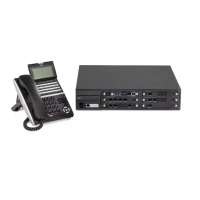• NAT Traversal
The NAPT (Network Address Port Translation) feature gives the SL2100 the ability to “traverse” its
own subnet. With NAPT used in the SL2100, the network administrator can place the CPU and the
VoIPDB in the customers LAN while still making it accessible to users outside the local LAN.
• Static NAT
This method is used to convert an address (a WAN-side address for the NAT router) previously
specified in the terminal configuration. For this method, a conversion table is statically set up for the
NAT router, and then a packet for a specific port is transferred to a specific terminal by using the port
forwarding function of the NAT router.
• Dynamic NAT
This method is used to automatically acquire the WAN-side global address for the NAT router and
convert it.
NAT Traversal
Besides ordinary NAPT feature SL2100 supports NAT Traversal which does not require Port
Forwarding setting at remote side router. This feature is effective when PRG 15-05-45 is set "1" (On).
Example of NAT Traversal network and necessary settings for System and IP Terminal are shown in
below Figure 1-23 Example- NAT Traversal on page 1-484, Table 1-34 Example - System Setting on
page 1-484 and Table 1-35 Example - IP Terminal Setting on page 1-485.
Actual input data should be set according to the required system.
Router A
Router B
172.17.0.254
10.1.1.2
IP Address
172.17.0.100
SIP Port
5060
172.16.0.254
10.1.1.1
VoIP LAN IP Address
172.16.0.10
VoIP GW IP Address
172.16.0.20
SIP Port
5080
Internet
System
IP Terminal
Figure 1-23 Example- NAT Traversal
Table 1-34 Example - System Setting
Index
PRG Default Input Data Remark
1 10-12-03 0.0.0.0 172.16.0.254 LAN IP address of Router A
2 10-12-07 0.0.0.0 10.1.1.1 WAN IP address of Router A
3 10-12-09 172.16.0.10 172.16.0.10 LAN IP address of VOIPDB
4 10-12-10 255.255.0.0 255.255.0.0 Subnet Mask of VOIPDB
5 10-46-14 0:OFF 1:ON NAT Mode
6 15-05-45 1 1 NAT RTP send port choice
SL2100 ISSUE 1.0
1-484
IP Multiline Station (SIP)
I

